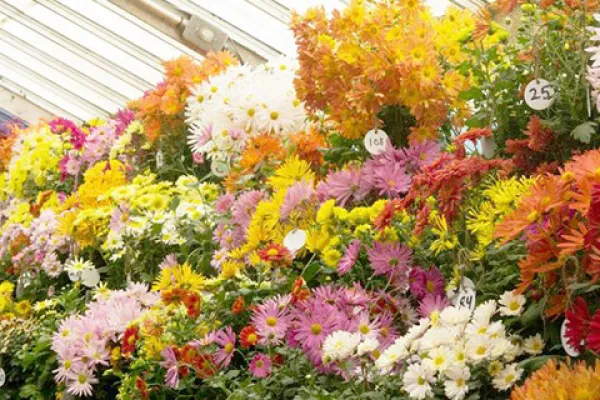Mum’s the Word: Fall Chrysanthemum Show Opens Nov. 1 in Lyman Conservatory
Events

Published October 29, 2014
It’s late fall at Smith—the time of the chrysanthemum.
Since the early 1900s, the college has been celebrating the many faces of Dendranthema x grandiflora with an annual Fall Chrysanthemum Show in Lyman Conservatory.
Work on this year’s show—which opens Saturday, Nov. 1, and runs through Sunday, Nov. 16—has been underway since the day after the Spring Bulb Show show closed, says Madelaine Zadik, manager of education and outreach for the Botanic Garden.
This year’s show is organized around a dragon theme, including a centerpiece of a dragon sculpture made by Hyun-Jung Oh ’14.
Zadik says the chrysanthemum show—which is open from 10 a.m. to 4 p.m. daily, with extended hours till 8 p.m. on Fridays, Nov. 7 and 14—draws thousands of visitors each year to view the multi-hued chrysanthemum cascades that line the walls of the conservatory and the exotic oversized standards.
Visitors also vote for their favorites amongst the hybrid mum varieties created by Smith students. The suggested donation is $5.
The kickoff to the show is a lecture by conservatory manager Rob Nicholson on Friday, Oct. 31, at 7:30 p.m. in the Campus Center Carroll Room. Nicholson’s talk, “Wild Collected,” will offer images and stories from 30 plant-collecting expeditions around the globe revealing the origins of some of the conservatory’s specimens. A reception and mum show preview will follow under the lights in the conservatory.
Experts say chrysanthemums, which were first cultivated in China as a flowering herb, are now the most widely grown potted plant in the United States.
For fans of other floral facts, here is our own 2014 Mum Show Index:
Asteraceae: Official name of the family to which mums belong—more commonly known as the aster or composite family.
15th century B.C.E.: Era when the first chrysanthemum was cultivated in China as a cure for headaches, among other uses. The flower appeared in Japan around the 8thcentury C.E.
1907: Earliest documented mum show at Smith.
183: Varieties of mums cultivated for this year’s show, including 83 student-created hybrids.
10: Approximate number of staff members and students who work on the mum show each year.
2: Genetically different plants required for crossbreeding to form a hybrid. Hybridization by Smith horticulture students involves hand pollination of the chrysanthemums.
Spoon, pompon and quill: Classes of mum flowers.
67 inches: Tallest mum in this year’s show; a maroon-colored spoon variety.
Ruth Crossman Pratt ’39: Creator of a rare hybrid mum that mimics an oxeye daisy. Zadik met Crossman at the mum show in 1999 when Crossman walked into the greenhouse and asked whether the hybrid she had worked on in her horticulture class six decades earlier was still being grown. (At the time, it was!)
2001: Year that Botanic Garden director Michael Marcotrigiano discovered a virus had stricken all but one of the student hybrids in the mum collection. After photographing them for a digital Hall of Fame, the diseased hybrids were laid to rest. Now, instead of making the hybrids part of the conservatory collection, they are preserved in the Hall of Fame.
Elsie Rose Eastman ’13: Winner of last year’s vote for the most popular hybrid.